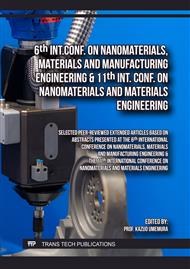p.15
p.21
p.27
p.33
p.41
p.49
p.59
p.67
p.75
Effect of a Low Corn Silk Flour Loading in Polybutylene Succinate Biocomposites on Degradability under Soil Burial and Sunlight Exposure Conditions
Abstract:
Polybutylene succinate (PBS) is a biodegradable polymer made from renewable resources and is therefore better suited for disposable products than recycled products. Nevertheless, PBS cannot be degraded in a timely manner (less than 180 days) to be claimed to be a compostable bioplastic. Corn silk is an agricultural waste material that degrades easily in the natural environment due to its small fibers. Therefore, this research aimed to study the degradability of PBS composites filled with corn silk flour (CSF) in small amounts of 5-15 phr and compared them with neat PBS by considering changes in mechanical properties. Corn silk was ground and treated by KMnO4 solution to improve compatibility before use. Both PBS and treated CSF were compounded using a two-roll mill and then shaped using an injection molding process. The obtained specimens deteriorated under natural soil burial and sunlight exposure conditions for 180 days. All specimens were evaluated through physical observation and various techniques to determine mechanical characteristics. The results indicate that the addition of CSF gave a slight improvement to the hardness, flexural strength, and modulus of the composites than those of neat PBS which increased with higher amounts of CSF. However, the impact strength of the composites was lower than that of neat PBS. For the degradability of PBS composites under soil burial condition, all mechanical properties obviously decreased with each increment of CSF content and the period, which revealed that the PBS/15 phr of CSF composites disintegrated within 60 days. Considering the results under the sunlight exposure condition, the CSF content insignificantly reduced the mechanical properties, indicating that the PBS/CSF composites can be preferentially degraded under the condition of soil burial since both PBS and CSF can be degraded by microbial enzymes in soil, whereas only PBS could be deteriorated in the UV exposure condition.
Info:
Periodical:
Pages:
41-47
Citation:
Online since:
June 2025
Keywords:
Price:
Сopyright:
© 2025 Trans Tech Publications Ltd. All Rights Reserved
Share:
Citation:



